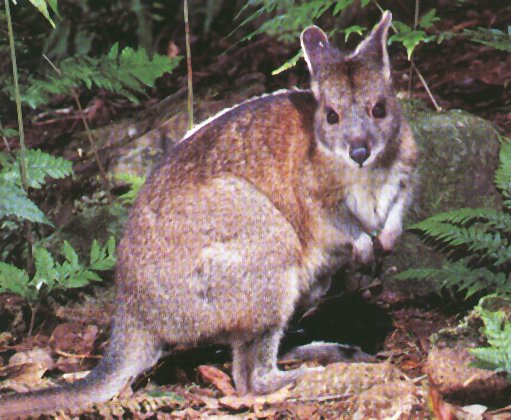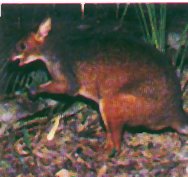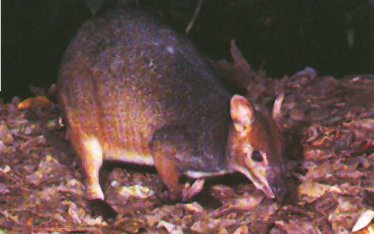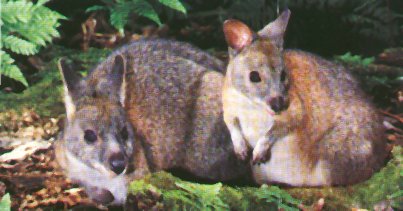
Pademelon

Order: Marsupialia Family: Macropodidae Genus & Species: Thylogale spp.
Restricted to New Guinea and nearby islands, the eastern coast of mainland Australia and Tasmania. The pademelon is a small relative of kangaroos, living in the forests of eastern Australia and New Guinea. It is threatened in some areas by forest clearance, and hunted as pests on farmland and pasture.
| Habitat The three Australian pademelon species particularly favour the rainforests of northern Queensland and Tasmania, where they make runways through dense vegetation. They also live in the sclerophyll forests of eastern Australia, which mainly comprise leathery leaved evergreen eucalyptus trees that receive heavy winter rain. The dusky pademelon of New Guinea, however, is also common in open, upland grasslands. In areas where extensive logging has taken place, pademelons remain common as long as there are scattered thickets and trees to provide shelter. Pademelons occur at their greatest densities in forests that border grassland or pasure, where they find many refuges and plentiful grazing. |
 |
 |
Behaviour The pademelon is a solitary, territorial animal that spends most of its life within an area of forest less than 1km across, with larger, stronger animals claiming the best grazing territories. Such territories often overlap, but neighbouring pademelons take little interest in each other. In areas of plentiful food, several individuals may graze together peaceably, and even warn each other of approaching predators, but there are no strong social bonds except that between a mother and her young. |
| The red-legged pademelon is active at any time of the day or night,
although it only ventures into open areas under the cover of darkness. The other pademelon
species are generally more wary and prefer to hide in thick cover before ventring anywhere
at night. |
Feeding The pademelon feeds mainly on young leaves, grasses and herbs. It nips off the choicest parts of the plant with its incisors and chews thoroughly with its large, flattened cheek teeth, creating a juicy pulp. Once swallowed, the mashed food is slowly broken down in a large, multi-chambered stomach, which superficially resembles the digestive apparattus of hoofed grazing mammals such as antelopes and cattle. In many parts of its range, the pademelon readily gorges itself on berries and fallen fruits, which are far more easily digested. |
 |
| In highland areas, the Tasmanian pademelon is often forced to dig in snow with its forefeet to find buried food in winter. It also raids crops for food, and is widely shot and poisoned by humans to control its numbers. |
 |
Breeding Pademelons mate after a brief courtship, and the female gives birth about a month later. As a marsupial, the young develops in a different manner to most mammals. Instead of growing inside the womb and gaining nutrients through an umbilical cord, it is born in an embryonic state. It crawls up its mother's fur and into a pouch on her belly, where it |
| attaches itself to one of her two teats. All the nutrients it needs
are supplied in her rich milk, and gradually the tiny, delicate creature develops into a
young pademelon. After six months, it leaves the pouch, but returns periodically to suckle from the original teat which now supplies high-fat milk for energy, until it is weaned two months later. The female pademelon mates again a month before her current offspring leaves the pouch, and gives birth just as the pouch is being vacated. As well as returning to suckle, the elder 'joey' may hop back onto the pouch to join its younger sibling when danger threatens. |